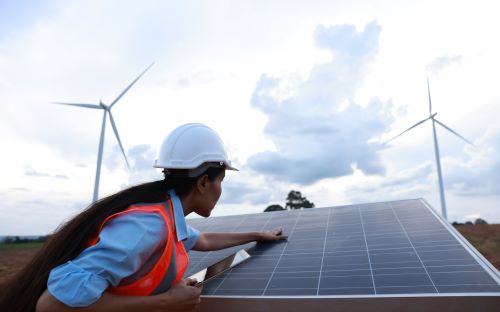India’s solar power industry is set for huge growth as part of efforts to produce cleaner and more reliable energy, but fears are growing about the lack of safe and environmentally-sound options for recycling and recovering the associated waste solar panels.
Features
Solar power waste: a growing problem for India
In February 2024, at the International Energy Agency (IEA) Ministerial Meeting and 50th Anniversary, prime minister Narendra Modi said in a video address to attendees: “India is the world's fastest-growing major economy. Sustained growth needs energy security and sustainability. In one decade, we went from the 11th-largest economy to the fifth largest. In the same period, our solar energy capacity grew 26-fold. Our renewable energy capacity also doubled. We exceeded our Paris commitments in this regard, ahead
of timelines.”
The prime minister’s statement came against the backdrop of India’s request for full IEA membership in October 2023.
“I am sure that the IEA will benefit when India plays a bigger role in it,” said Modi.
In October 2023, the IEA predicted that by 2030, 18 per cent of India’s electricity will be generated from solar sources, up from the current six per cent.
“The shining example of the growth in clean energy investment is solar, which in 2023 is set to attract more capital than global oil production for the first time ever. This reflects the changing tide in world energy,” the IEA’s Fatih Birol said.

Solar panel waste set to grow
It’s definitely sunny times, not just for the solar power industry but also for anyone who understands the importance of transitioning from fossil fuels to clean energy for the sake of our environment and society. Unfortunately, there’s an enormous caveat that very few are talking about –the solar panels need to be disposed of at the end of their life, and solar panel waste is set to grow exponentially as installations of the equipment boom.
To put solar waste in context, solar panels have finite lifetimes, typically working well for about 20 to 30 years. When these panels break or become too degraded for normal use, they’re recycled, repurposed or discarded. Today, recycling solar panels by separating each layer is a complex, extremely energy-intensive and expensive process, and with a limited market for used panels, the vast majority of decommissioned solar panels end up in landfills, where they release toxic chemicals and heavy metals into the environment.
A new study published in March 2024 revealed alarming projections regarding India’s solar waste output. India’s solar waste is expected to jump to 600,000 tonnes by 2030 –equivalent to filling up 720 Olympic-size swimming pools –from the current 100,000 tonnes due to rapid deployment of new solar plant capacity. The study, Enabling a Circular Economy in India’s Solar Industry: Assessing the Solar Waste Quantum, by the Ministry of New and Renewable Energy and independent think tank Council on Energy, Environment and Water (CEEW), stated that around 67 per cent of this waste will come from five solar and renewal energy-rich states: Rajasthan, Gujarat, Karnataka, Andhra Pradesh and Tamil Nadu.
Solar panel waste to triple by 2030
India’s current installed solar capacity of 66.7 GW (in the financial year 2022–23) generated about 100,000 tonnes of solar waste in 2022–23, and this is predicted to increase to 340,000 tonnes by 2030 – more than three times the current level. This will include about 10 kilotonnes (kt) of silicon, 12–18 tonnes of silver and 16 tonnes of cadmium and tellurium, which are pivotal for India’s mineral security.
The study underscores the significance and importance of recycling solar waste to recover these essential materials. The process of recycling will therefore reduce India’s dependency on imports of these materials and bolster the country’s mineral security.
According to the Critical Mineral List from the Indian Ministry of Mines, components including silicon, copper, tellurium, and cadmium are considered critical minerals for the country’s current and future technology manufacturing needs.
The study found that the remaining 260 kt of waste will arise from new solar power capacity deployment between 2024 to 2030.
The report also forecasts that cumulative solar waste from existing and new clean energy installations will increase to about 19,000 kt by 2050, with 77 per cent of this stemming from new deployed solar capacity. The report adds this is an opportunity for India to emerge as a leading circular economy hub for the solar industry, therefore fortifying resilient solar power equipment supply chains.
India’s solar capacity is predicted to increase from the current 66.7 gigawatts (GW) (2023 figure) to 292 GW by 2030, making solar PV waste management crucial for environmental, economic and social reasons.
Amended Electronic Waste Management Rules
According to CEEW, solar waste refers to both discarded solar modules as well as scrap generated during the cell and module manufacturing processes. Modules can be discarded either when solar PV modules reach the end of their functional life or if they become damaged during transportation, handling and installation. CEEW states that solar waste in India should be treated appropriately according to the Electronic Waste Management Rules 2022, which were amended in April 2023 to bring solar photovoltaic cells, panels and modules within their scope. The rules require businesses that manufacture or produce solar photovoltaic cells, panels and modules to arrange for the collection, storage and dismantling of their solar equipment waste.
Arunabha Ghosh, CEO of CEEW, said: “India must proactively address solar waste, not just as an environmental imperative but as a strategic necessity for ensuring energy security and building a circular economy.
“As we witness the remarkable growth of solar from only 4 GW in March 2015 to 73 GW in December 2023, robust recycling mechanisms become increasingly crucial. They safeguard renewable ecosystems, create green jobs, enhance mineral security, foster innovation, and build resilient, circular supply chains.”
Reducing solar waste
Since the manufacturing of solar panels requires the use of critical minerals, experts agree there is an urgent need for India to ensure circularity in the solar panel manufacturing and solar power energy generation industries. Circularity aims to reduce waste as much as possible by recycling, while keeping the product’s value intact for a longer time.
“Since the e-waste regulation bans landfilling hence, recycling and recovering materials therein is the only option,” Jaideep N. Malaviya, managing director of Malaviya Solar Energy Consultancy and board director at the International Solar Energy Society, told Energetica India.
Also, waste from end-of-life solar panels presents an opportunity to recover valuable materials and create jobs through recycling.
Malaviya added: “Recycling will become an industry in itself and create job opportunities and provide entrepreneurial opportunities.”
According to the International Renewable Energy Agency, by 2030, the cumulative value of recoverable raw materials from end-of-life solar panels globally will be about $450 million, which is equivalent to the cost of raw materials currently needed to produce about 60 million new panels. Diverting solar panels from landfills to recycling saves space in landfills while also capturing the value of the raw materials contained in the unwanted panels.
Recycling not cost-effective
However, in India, a major factor that discourages investment in recycling efforts is that solar panel recycling – and most recycling overall – is not currently cost-effective or widely adopted. For instance, a large proportion of the glass recovered from the panels is of poor quality compared to the original glass, so it can only be used by inferior, cheaper glass-containing products, meaning there is little money to be made from recycling.
Also, in India, many solar power plants are in remote areas, so the transportation of the heavy glass panels to recycling plants locate elsewhere is expensive, further reducing the profit margins from recycling.
Experts warn that the limited amount of solar panel recycling infrastructure currently available in India is a major challenge, plus the fact that much of the current recycling and recovery is undertaken by small, informal operators in the unorganised sector, with scrap traders often handling waste in an unscientific manner. This poses the risk of harmful substances from panels leaching into land and soil, causing environmental contamination.
Experts agree that large amounts of solar waste, like other electronic waste, ends up in the informal sector, where workers face safety risks when dismantling the equipment and receive poor wages. Although studies have shown that heavy metals in solar panels, including lead and cadmium, can contaminate groundwater and affect plant life, research also demonstrates that these metals can cause harm to human health.
Other challenges around the safe and effective recycling and recovery of solar panels and the materials contained in them range from technological and infrastructural hurdles, funding, industry awareness and more. This is in addition to the lack of authentic data, monitoring and regulation of the entire solar waste recycling and recovery sector due to the absence of stringent rules.
Invest in research
Experts also argue that India needs to invest in research and development into efficient recycling methods that recover both bulk and high-value components from solar waste. They have also called for studies to be undertaken to understand and prevent the common causes of early breakdowns and power loss in solar panels and their associated equipment, such as damage from extreme weather, as this can extend the lifespan of panels, in turn reducing waste and the need for recycling and recovery.
In addition, ‘green’ certificates can provide a level-playing field and encourage recycling and mineral recovery by the industry, they add.
Akanksha Tyagi, programme lead at CEEW, says: “Solar waste management will be a huge challenge soon and necessitates immediate action by private sector players. However, the availability of India-specific data remains a critical gap in devising strategies. A granular spatial and temporal estimation of solar waste is the first step in designing policy mechanisms and infrastructure deployment.”
Ashish Khanna, CEO at Tata Power Solar, noted that a market-driven initiative will be essential for a thriving waste collection and recycling industry. “Stakeholders forming a part of the Indian solar industry should take responsibility to invest in recycling technologies, finance routes and feasibility examination by pilot projects,” he said.


FEATURES

India’s path to net zero: a work in progress
By Orchie Bandyopadhyay on 08 April 2025
India is implementing a variety of clean energy measures to hit its target of net zero greenhouse gas emissions by 2070, including plans to rapidly scale up the generation of nuclear power. However, climate experts say significant finance will be required from developed countries to phase out coal power, accelerate renewables deployment and expand the national electricity grid.

Too hot to handle: early arrival of heatwaves in India sparks calls for action to protect workers and the public
By Orchie Bandyopadhyay on 08 April 2025
Temperatures in India in February 2025 were the hottest since records began over a century ago, prompting warnings the country needs to urgently step up efforts to protect both workers and the general population from the health risks posed by extreme heat and humidity.

